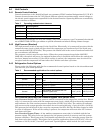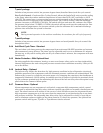
Maintenance
16
6.5.3 Thermostatic Expansion Valve
The thermostatic expansion valve (TEV) keeps the evaporator supplied with enough refrigerant to
satisfy load conditions. It does not turn the compressor on or off, but maintains proper refrigerant
super heat in the suction gas to the compressor.
Determine TEV operation by measuring superheat. If too little refrigerant is being fed to the evapora-
tor, the superheat will be high; if too much refrigerant is being supplied, the superheat will be low.
The correct superheat setting is between 10° and 15°F (5.5° and 8.3°C), under normal load conditions
and “steady-state” operation. Some models of InteleCool2 will be supplied with a non-adjustable
expansion valve, so no adjustments are possible.
To adjust the superheat setting when an adjustable valve is used:
1. Remove the valve cap from the base of the valve.
2. Turn the adjustment stem counter-clockwise to lower the superheat.
3. Turn the adjustment stem clockwise to increase the superheat.
To determine superheat:
1. Measure the temperature of the suction line at the point where the TEV bulb is clamped.
2. Obtain the gauge pressure at the compressor suction valve.
3. Add the estimated pressure drop between bulb location and the suction valve.
4. Convert the sum of the two pressures to the saturated temperature.
5. Subtract this temperature from the actual suction line temperature. The difference is superheat.
6.5.4 Air-Cooled Condenser
Restricted airflow through the condenser coil will reduce the operating efficiency of the unit and can
result in high compressor head pressure and loss of cooling.
Clean the condenser coil each time the evaporator filters are replaced. Check for bent or damaged coil
fins and repair as needed. Check all refrigerant lines for leaks. Clean the condenser coil of all debris
that will inhibit airflow. This can be done with compressed air or commercial coil cleaner.
6.6 Compressor
Infrequently, a fault in the motor insulation may result in a motor burn. However, in a properly
installed system, burnouts rarely occur. Of those that do, most are the result of mechanical or lubrica-
tion failures, resulting in the burnout as a secondary consequence.
If the problems that can cause compressor failures are detected and corrected early, a large percent-
age can be prevented. Periodic maintenance inspections by alert service personnel on the lookout for
abnormal operation can be a major factor in reducing maintenance costs. It is easier and far less
costly to take the steps necessary to ensure proper system operation than it is to allow a compressor
to fail and require replacement.
When troubleshooting a compressor, check all electrical components for proper operation, including
all fuses and circuit breakers and pressure switch operation.
If a compressor failure has occurred, determine whether it is an electrical or mechanical failure.
Mechanical Failure
A mechanical compressor failure will not be indicated by a burned odor. The motor will attempt to
run. If you have determined that a mechanical failure has occurred, the compressor must be replaced.
NOTE
Make no more than 1/4 turn of the stem at a time. As long as 30 minutes may be required
for the new balance to take place.


















